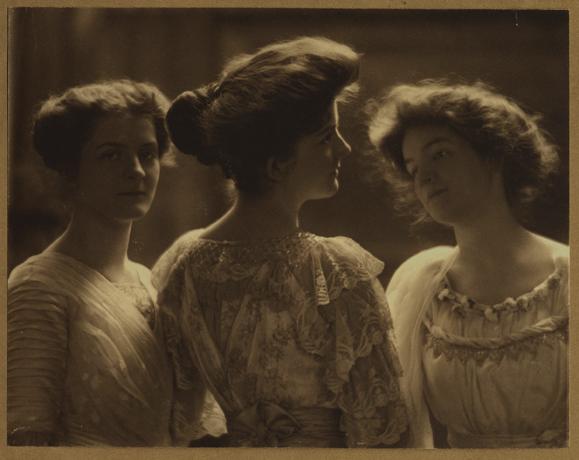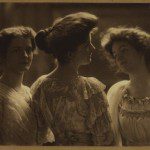The Dawn of Photography
By • July 26, 2011 0 1690

These days, we take pictures for granted. They’re in our heads, in our phones, on our computer, in our digital cameras, makeable, and erasable. We live in an ocean of photographic imagery—the world of click and snip. In this environment, it’s hard to tell what’s art and what’s not. The question of art at the dawn of the age of photography, and the decades that marched ahead, was a question that was asked with great passion and answered in infinite ways by several generations of photographers, all of them searching for ways to elevate a technical innovation into the rarefied clouds of high art.
Two current exhibitions, at the National Gallery of Art and the Phillips Collection, take up the banner of that debate, how it was conducted, and the results it produced. Both exhibition titles sound like Masters of Fine Arts theses, but don’t be put off by that. If you have any interest in photography and art, photography IN art, and, for that matter, if you have a camera and use it often, you’ll find these exhibitions thought-provoking, imagination-stimulating, debate-instigating, and, with the presence of so many great works of photography, a great pleasure.
The National Gallery of Art exhibition, “The Pre-Raphaelite Lens, British Photography and Painting, 1848-1875,” is, as the title suggests, narrowly focused in time and art. It successfully connects the dots between early photographers, like the remarkable Julia Cameron and Henry Peach Robinson, to the groups of artists encouraged by the English uber-critic and cultural sage, John Ruskin, led by the likes of Dante Gabriel Rossetti. The latter group was devoted to the art which preceded Raphael, hence the name they adopted. Ruskin and the Pre-Raphaelites were also keenly interested in the arrival of photography, which they tried to incorporate into their art.
The Pre-Raphaelites constitute a tight group of rebels—albeit very well dressed, crusty, upper class Victorian elite rebels. Ruskin, a Renaissance man of endless expertise, was a kind of titular leader and arbiter of art and culture in England, if not Europe, at mid-century when the effects of photography were beginning to be felt.
Pre-Raphaelites and photographers intersected at so many points that the connections seem almost incestuous. Artists like Rossetti believed that they should paint from and in nature, getting the very effects that photography could produce, and exacting details of landscape and dramatic details of personality, dress and features in portraits. They also loved to create illustrative paintings of scenes from poetry, literature, Shakespeare and legend—something photographers like Cameron also did, surprisingly, to much greater effect.
The Pre-Raphs, in a way, rejected the modern and tried to achieve an intense romanticism, especially in their efforts at portraits. Except for a few paintings—Rossetti’s effects in color and Ruskin’s watercolors—the photographers seem almost always to trump the painters. But then the painters had no one of the stature and brilliance of Cameron in their ranks.
“TruthBeauty: Pictorialism and the Photograph as Art, 1845-1945,” at the Phillips Collection, is broader in its reach, wider in its geography, and more varied in the work on the walls. In the exhibition, the debate and comparison between photography and painting continues in the realm of photography as a vehicle for great and fine art.
The photographs in this exhibition have a haunting quality. They seem touched by some sort of mist, and it’s that artful, powerful quality that pervades much of the works of the photographers in “TruthBeauty” at the Phillips. There’s an insistence that a photograph is, can, and should be more than just a photograph—a mirror to reality.
Cameron, who may be a guiding, informing spirit, is represented here. But those photographer-artists who came later: Edward Steichen, Gertrude Kasebier, even the modernistic Edward Weston, and the edge-pushing F. Holland Day acknowledge the debt and direction of photography of art. In landscapes and in cityscapes, is there anything more haunting than Steichen’s “Flatiron—Evening”?
Cameron in her portraiture, which seems more like Tolstoyan novels, is more of a painter than the painters. Consider, for instance, Lord Tennyson, the great Victorian of British nationalism and empire, as painted first by George Frederic Watts in somber, beautifully lit fashion. Then look at Cameron’s photo portrait (dubbed “The Dirty Monk”), where you can see some wild, inner restlessness—something of the fanatic in the face. Tennyson, by the way, much preferred “The Dirty Monk.”
Still, nothing quite like Rossetti’s portrait of Jane Morris, the wife of his friend and his paramour, was achieved by the photographers. Here color and details create a miracle of hypnotic beauty.
“TruthBeauty” is rich (120 images) and diverse, a best of the best in many ways, and the Phillips is the last stop on a grand international tour, which was organized by the George Eastman House and the Vancouver Art Gallery.
“TruthBeauty” continues at the Phillips Gallery through January 9. “The Pre-Raphaelite Lens” continues at the National Gallery of Art through January 30.
- Elias Goldensky, ‘Portrait of Three Women,’ ca. 1915. Platinum print. | At the Phillips Collection. Courtesy George Eastman House, with permission of Ellen Golden



